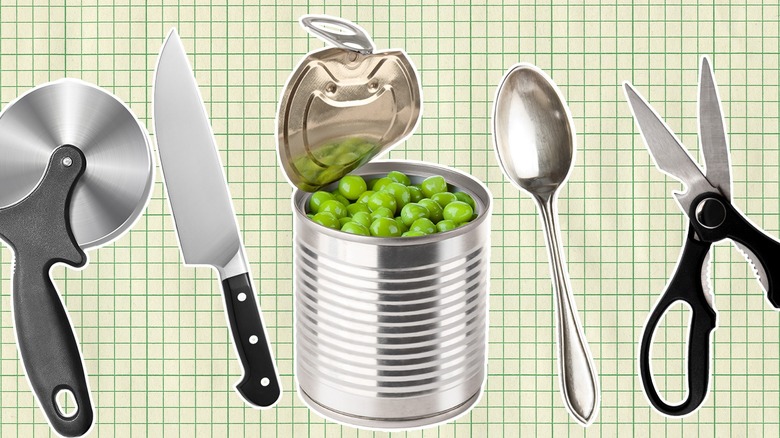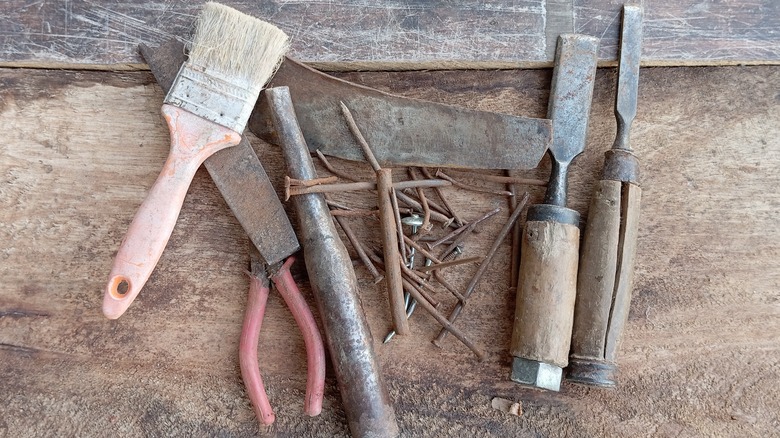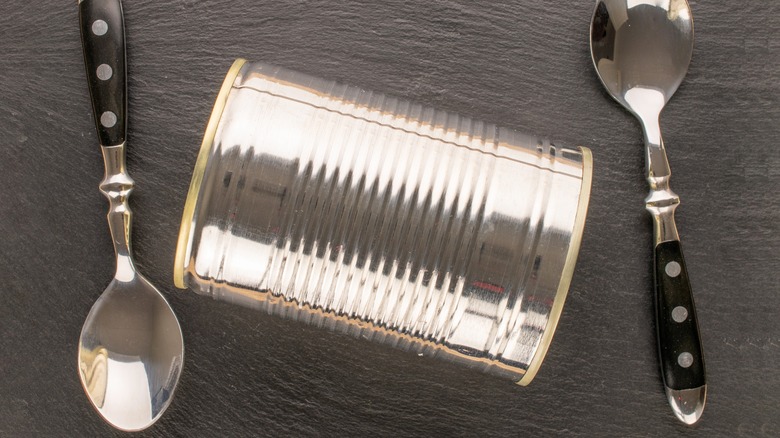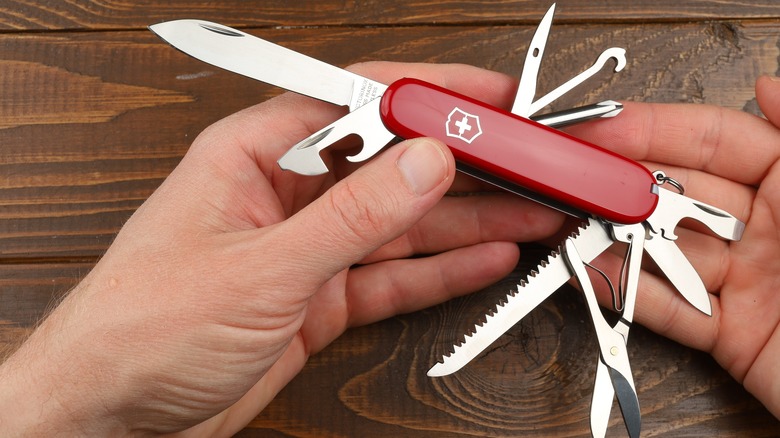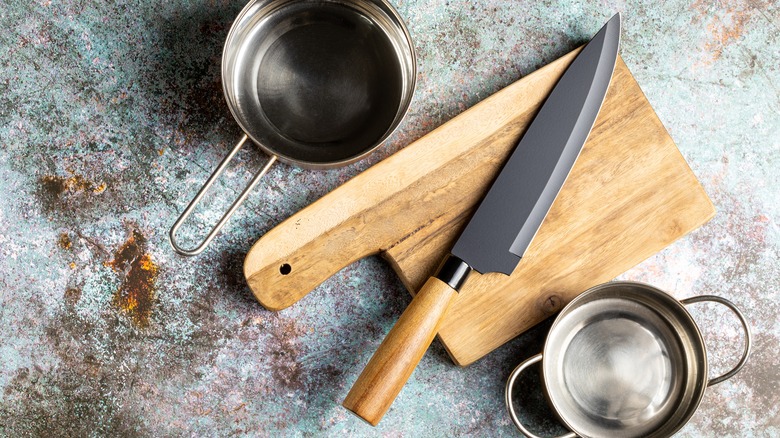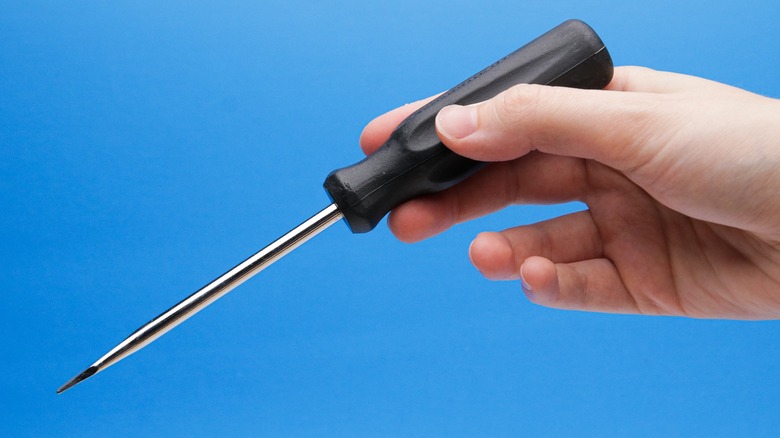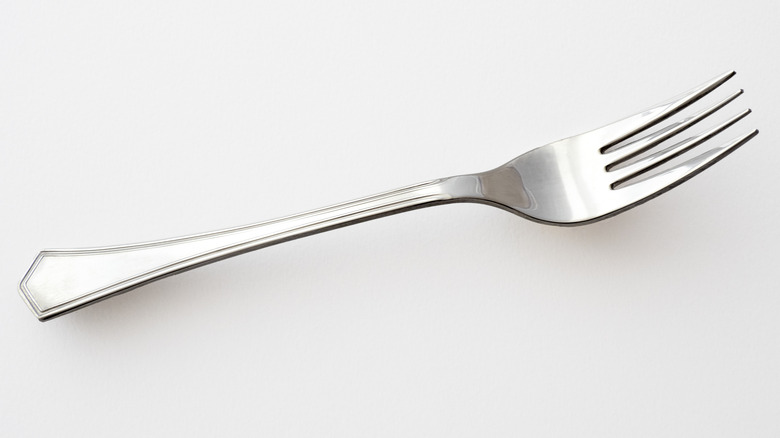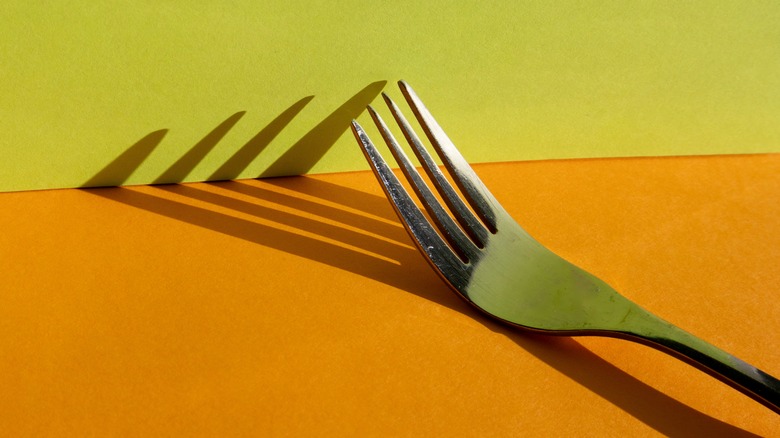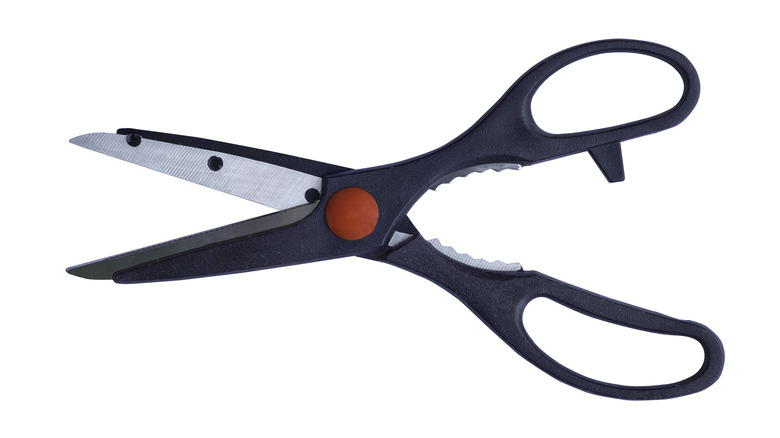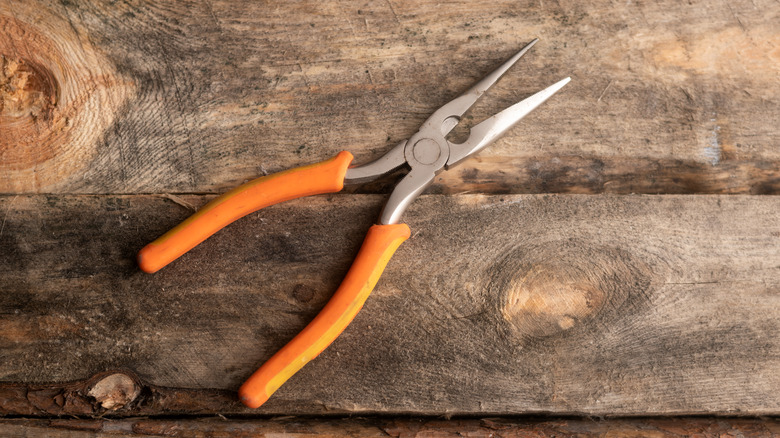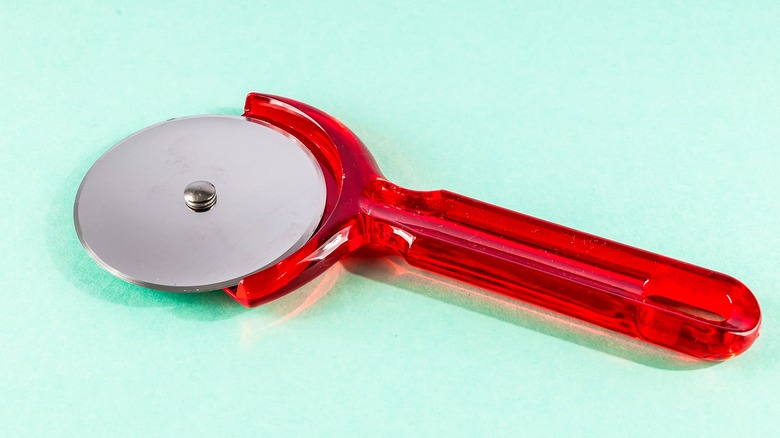The Best Ways To Open A Can Without A Can Opener
Napoleon Bonaparte is famous for many things: his (actually average) height, his revolutionary politics, and his giant hat. But he's also the reason our pantries are stocked with canned foods. In 1795, he promised a hefty prize to anyone who could come up with a way to keep the army's food from spoiling. The winner had submitted a design for a glass canning method, but not long after, inventor Peter Durand developed a thick can made of wrought iron and tin for preserving food. The can opener hadn't been created yet so the suggested means of opening such cans was with a hammer and chisel.
Over time, the design of the can thinned out as steel was used in place of tin, and in the mid-1800s, the first can opener was invented, decades after canned food. It had a blade that pierced through the can's lid while another part sawed the edges. However, it left a jagged edge and wasn't the safest tool to use. Thankfully, around the 1920s or 1930s, the standard crank design was invented by Charles Arthur Bunker.
Unless your cans are made with a convenient pull tab, Bunker's design is still used today and the can opener is a standard tool in almost every kitchen. But what do you do if you find yourself without one? There are a few methods you can try.
Chisel it open
Before can openers were invented in the 1850s, a chisel and a hammer were the tools most people used to open their cans. In fact, this was the method recommended by the cans' manufacturer, which makes sense once you know that early cans were crazy thick, making them harder to open than the cans we know today.
While the hammer-and-chisel method was effective, it wasn't exactly convenient. It required a lot of brute strength, and, of course, required you to have a hammer and chisel on hand. As a result, thick, heavy cans weren't super popular with the general public. When they were first invented, workers could only make six every hour, making them somewhat rare to own. By the time they were being sold on shelves, can openers were available in some form, so regular people never needed to open cans with a hammer and chisel. However, if you're ever in a situation where you're out of a can opener but have a chisel and hammer nearby, you can always revert to the original method of opening a can.
Pop its top with a metal spoon
One of the most popular ways to open a can without a can opener is to use a spoon. For this to work you'll need a sturdy metal spoon, preferably a table or dinner spoon, which are the larger or the two types of spoons that usually come in cutlery sets. Plastic and wooden spoons won't be sharp enough for this.
Grip the spoon so your pinky and ring finger are around the top of the bowl, or the curved part of the spoon where the food sits. Your middle and pointer fingers should be around the stem, just above the bowl. With your other hand, hold the can upright and steady. It helps to do this on a solid surface. Next, align the tip of the spoon along the inner ridge of the top of the can. Rub the spoon back and forth with pressure to create a groove. This creates a weak spot, and if you keep the pressure on it, the spoon will eventually pierce through the can. Continue to work the spoon around the inner ridge of the lid until you can pop it free.
This method isn't as easy as just using a can opener, but it's still relatively simple. However, be cautious; this method of opening a can, like most of the methods on this list, is more likely to leave a jagged edge. These can cause deep cuts if you aren't careful.
Puncture it with a pocket knife
The pocket knife method of opening cans is pretty straightforward, but there are actually two methods you can use depending on what kind of pocket knife you have. If you have a multitool pocket knife, like a Swiss Army knife, there may be a can opener tool on it. Otherwise, for more basic pocket knives, you'll need to puncture the top.
The can opener tool on Swiss Army-type knives is similar to the original can opener design. The blade has a pointed tip with a cutout in the bottom center of it. The part of the cutout closest to the base is shaped like the letter C, creating a pointed hook, while the opposite side of the cutout is a sharp, acute angle. To open a can with this blade, align the sharp, angular part of the blade along the can's inside rim and the hook along the bottom of the outside rim. Press down to puncture the top, using the hook as leverage, and work your way around the can.
For a standard pocket knife or even a small, sharp kitchen knife, like a paring knife, the method is a little different but not too complex. Line the tip of the blade along the inside rim and carefully puncture the top. Then cut around the inside rim. Again, be very careful, as these methods can lead to jagged edges.
Sand down the edge with a rock
Using a spoon or a knife to open a can is all well and good, but what if you've got no tools at all? Even if you're lost in the woods or stranded on a deserted island, you aren't completely out of luck; you can still open a can of food (although rescue might be another matter).
For this method to work, you'll need a large rock or a slab of concrete nearby. Essentially something on the ground with a rough surface. No, you're not going to bash the can open; instead, you're going to start by flipping the can upside down. Next, you'll rapidly rub the top of the can against the rock or concrete. It may take a minute or two, but eventually, you'll be able to sand down the edge, which breaks the seal and frees the top. Just be careful not to spill the can when you lift it up!
While this isn't the most efficient — or sanitary — method if you have other tools, it's a great option in a survivalist situation. It only takes a few minutes, and doesn't leave edges that are sharp and jagged like most of the other methods. That being said, maybe take a second now to ensure there's a can opener in your survival food kit.
Use a chef's knife like a lever
Chef's knives are large, multi-purpose knives used primarily to slice and chop, but they can be used to open cans — just in a way that's a little different than a pocket knife. A small knife can puncture the top of the can easily, but you may have a harder time with a chef's knife since you won't be able to navigate it around the rim as smoothly.
Therefore, instead of piercing the can with the point of the knife, you're going to use the heel, which is the lower, often square, part of the blade near the handle and opposite the point. With the knife in your dominant hand, hold the can in the other hand on a flat surface. Press the heel of the blade into the top of the can along the inner rim until it pierces through the metal. Rock the knife slightly to open the hole further, then continue using this method all the way around the can.
The chef's knife method of opening a can only takes a minute or two to complete, but this one has to be done very carefully. Not only does this method leave a jagged edge on the can, but one wrong move with the knife can lead to bloody fingers. Go slowly with this method, ensuring you have complete control over the knife and that your fingers are out of the way of the blade.
Hammer it with a flathead screwdriver
While there's nothing really wrong with the old-school way of opening cans with a hammer and chisel, most people don't have chisels lying around their houses. Hammers, yes, but not chisels. However, in place of a chisel, you can use a flathead screwdriver.
To open a can using this method, first place it on a flat, stable surface. If you can get someone to hold the can steady, even better. Hold the screwdriver in your non-dominant hand and position the flathead so the tip is upright against the lid and flush against the sides. Next, use a hammer to tap the end of the handle in a way similar to a chisel. Once you've pierced through the top, continue working around the edge until the lid comes free.
Depending on your strength (and the strength of your flathead screwdriver), you may be able to open your can without the hammer. Wedge the flathead along the edge and hit the handle with the palm of your hand instead of the hammer. This might be a little harder and less comfortable but is an alternative option if you've got a screwdriver handy but not a hammer.
Wear through the top with a fork handle
We've gone over how to open cans with spoons and knives, so now it's the fork's turn. Though forks may have once been considered an affront to God, today they're a staple in most kitchens and dining spaces. If you're short a can opener but do have a fork, you can use it to open your can.
This method is very similar to the spoon method. Any size fork will work, but it needs to be fully metal, even the handle. That's because the tip of the handle is what you'll use to weaken the can's lid. Flip the fork upside down so the end of the handle is pressing against the top of the can along the inside rim. Rub the fork back and forth in one spot rapidly until it becomes thin. Flip the fork over and use the tines to pierce through the top, then continue cutting around the edge. This method is easiest if you're wearing gloves to get a good grip and protect your hands.
Pierce the top with fork tines
There is another way to use fork tines to open a can, although it is a trickier option. This method is a little more time-consuming than the previous one but will work if you're desperate, and if the handle of your fork is made of something other than metal.
Position the fork so it's upright over the can, with one tine on the inside edge and the other three on the outside. You can then hit the handle of the fork with your hand or something like a hammer or rock, similar to how you would use a flathead screwdriver. Once you manage to puncture the top, keep working your way around, piercing the lid as you go. Note that your fork probably won't recover from this, so if it's the only one you've got or it's valuable, this might not be the best option.
Cut through it with scissors
Scissors are a tool found in most households, unless, of course, you have children, in which case you'll never be able to find a pair of scissors when you need them. And if you're lacking a can opener, you can use scissors to open your cans.
Both standard scissors and kitchen shears work well for this can-opening method, which works very similarly to using a small knife to open a can. Open up the scissors and line one blade along the inside edge. Hit it against the inner edge of the can's lid to puncture a hole in the top. Take your time and note that this may take several tries. Once there's a hole, cut along the inside of the can all the way around until the top comes off. This may take some maneuvering, but you should be able to open your can up within a few minutes. Like with most of the other methods, this can leave a jagged edge along the can, so proceed with caution.
Stab it with needle nose pliers
Inside a toolbox, you'll typically find a pair of pliers. One of the most common types is needle nose pliers, which have long, tapered jaws capable of maneuvering in tight places. They can be used for various things, such as working with wires and making jewelry. You can even pit a peach with pliers. You can also use needle nose pliers to open a can if your can opener has gone MIA.
This method works similarly to many of the other methods on this list: through a combination of a sharp edge and brute strength. With the can on a flat, stable surface, keep the pliers closed and use the tip to stab through the top of the lid. After you've made a sufficient-sized hole, you can use the pliers to pull the lid from the sides and work the top all the way off, or at least bend it back enough to access the food inside.
Slice the lid with a pizza cutter
Maybe you usually have a fully-stocked kitchen, but your can opener broke and you haven't had a chance to get a new one. In that case, you'll probably have a pizza cutter that you can use instead.
Sure, it's not the prettiest, the safest, or easiest way to open a can, but it'll do in a pinch. Again, you'll want a stable, flat surface to set your can on. Keep the can stable with your nondominant hand and use your dominant hand to hold the pizza cutter. Use the cutter to slice back and forth across the top of the can, cutting across one way and then the other to create an X-shape. It may take a few minutes, but once you've gotten through, you can use the edge of the pizza cutter to lift the edges of the can's lid and peel back the top further. Use this method with caution, however, as the edges of the can will be jagged and the pizza cutter could easily slice your hand or fingers if you aren't careful. Note that if you try this method, you should probably sharpen your pizza cutter after.
